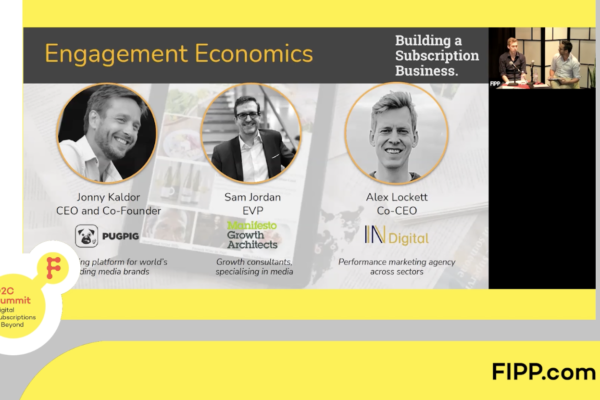Engagement Economics: How to define, measure, and enhance engagement for subscription success
The Building a Subscriptions Business Collective brings together Manifesto Growth Architects, Pugpig, and In Digital, with a firm focus on helping companies to create successful subscription offerings. At the FIPP D2C Summit in June, the group came together to talk about a new research project they are undertaking into the importance of engagement in building a successful subscriptions business, and how key metrics can be used to help determine strategy.
Opening the session, Jonny Kaldor, Founder & CEO of Pugpig, outlined the research parameters:
“We’ve been wanting to do this piece of work for some time, we talk about engagement all the time, we talk about the value of engagement. So we’ve actually kicked-off over the past couple of months, a piece of work to create a report called ‘Engagement Economics’ around trying to understand the link between engagement and driving value in the business.”
“And it all starts with a hypothesis… The hypothesis asks the question as to whether increased engagement becomes a leading indicator in pushing audiences through from being anonymous followers, to identifiable traffic, registered users, transactional audiences, and finally into premium users as members or subscribers. Should engagement be the leading indicator for performance? What’s the connection between engagement and commercial outcomes? And what are the best ways to track and optimise engagement?”
Of course, in order to begin answering those questions, it is important to first determine what ‘engagement’ itself really is. Alex Lockett, co-CEO of In Digital, says that this can mean different things for different people, and is ultimately about linking a number of different considerations together by a common thread:
“From a customer’s perspective, engagement is really about how deeply connected they feel to a business and a product, and how likely they are to feel ready to hand over their hard earned cash. From a business’s perspective, it’s about the tactics and activities you can use to make people feel more engaged. But really the kind of crux of it is that it’s about behaviour and how do customers behave differently based on their level of engagement?”
“So we’re asking a number of different publishers, with a number of different models, how they view engagement within their business. We’re also asking them about conversion rates, retention rates, and ultimately the impact on commercial performance that those different levels of engagement drive. So we’re hoping to bring together a lot of insight from lots of different publishers to be able to quantify what the impact of engagement is on future customer value.”
Preliminary Results
Manifesto Growth Consultants EVP, Sam Jordan, explains that the research is now underway, and has already thrown up some interesting preliminary results.
“I think it’s interesting because you’ve got three different answers,” Jordan tells us. “We had quite a lot of people at the interview stage say that they think engagement is very important. Very few at the other end of the scale said it’s not very important at all. And then a lot in the middle. I think this might reflect some of the different business models at play. If you’re still more of an advertising led business model then you might not see quite the same value in engagement as someone who is more kind of subscriptions and membership.”
“Our take on this from our experience is that we see engagement as a driver of revenue across every single business model. And so if I take the example of an advertising or affiliate led business, engagement really is about getting the same people back more often, which lowers your cost of acquisition, but you should also learn more about those people as well. So we would see engagement in that way as a key driver of value, however you’re trying to make money.”
Starting your journey
The Building a Subscriptions Business website outlines its approach to success in this area, providing 9 top tips on how best to optimise your subscriptions play.
- Focus around customer engagement
- Connect customer and commercial value
- Plan capabilities and ways of working
- Design the product with a customer focus
- Build incrementally and at speed
- Launch, learn and iterate product
- Establish effective measurement of subscription KPIs
- Leverage content to drive subscriber acquisition and engagement
- Optimise and enhance customer journeys to boost conversion
During the session, Jordan explained some of the key metrics that publishers can use to start measuring success, and why total number of active days is becoming such a useful one in the industry.
“It’s somewhat reflective of the kind of habits that you’re trying to establish with people, and how often you’re getting them back. What people tend to find is that across their userbase, they get a level of stability and a metric emerging about what a good level of engagement looks like for you. And it is really the simplest number to get your head around, for everyone in the organisation, i.e. if we can just get people back for one more day, we’ll have that much of an impact on engagement and therefore revenue in the future.”
The session included a live Q&A and you can watch everything in full via the video above.









